
CleanSpace Encapsulation (Before)
In order to prevent water from pooling in the crawlspace from exterior seepage, we installed a full perimeter interior dewatering system with a sump pump. We dug an interior drainage trench system, roughly 12 inches wide throughout the perimeter of the crawlspace. Inside the trenches we laid filter cloth that covers the entire bed of soil and ran the tile to an UtraSump pump. Lastly, we placed a bed of stone over the tile to allow extra drainage and to cover the trench. In order to control excess humidity and moisture in the crawlspace, we installed the Cleanspace an Encapsulation liner. The process of installing the encapsulation membrane is to install the wall liner around the full perimeter of the crawlspace. We used anchors to mechanically fastened the encapsulation liner and to the foundation wall. Next, we applied CleanSpace Encapsulation along the walls and floors of the crawlspace. The point of the encapsulation is to isolate the airspace from the soil as well as the moisture that is caused by temperature change on the foundation. This allows the air space to be conditioned. Finally, an AprilAire full crawlspace dehumidifier was installed in order to extract moisture from the air space, and more importantly the lumber, to prevent mold growth from occurring in the future.
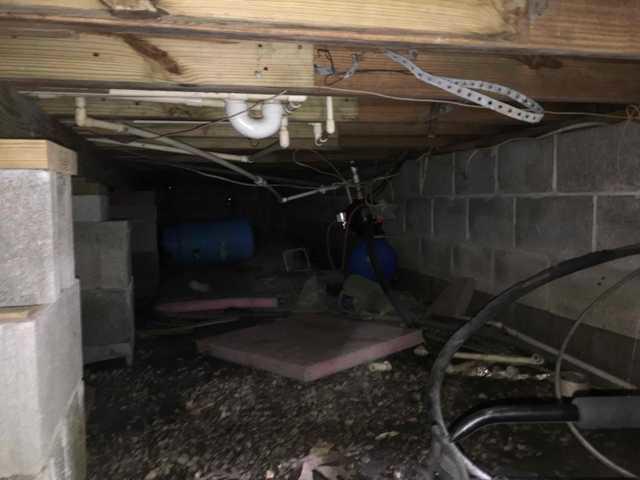
CleanSpace Encapsulation (Before)
In order to prevent water from pooling in the crawlspace from exterior seepage, we installed a full perimeter interior dewatering system with a sump pump. We dug an interior drainage trench system, roughly 12 inches wide throughout the perimeter of the crawlspace. Inside the trenches we laid filter cloth that covers the entire bed of soil and ran the tile to an UtraSump pump. Lastly, we placed a bed of stone over the tile to allow extra drainage and to cover the trench. In order to control excess humidity and moisture in the crawlspace, we installed the Cleanspace an Encapsulation liner. The process of installing the encapsulation membrane is to install the wall liner around the full perimeter of the crawlspace. We used anchors to mechanically fastened the encapsulation liner and to the foundation wall. Next, we applied CleanSpace Encapsulation along the walls and floors of the crawlspace. The point of the encapsulation is to isolate the airspace from the soil as well as the moisture that is caused by temperature change on the foundation. This allows the air space to be conditioned. Finally, an AprilAire full crawlspace dehumidifier was installed in order to extract moisture from the air space, and more importantly the lumber, to prevent mold growth from occurring in the future.
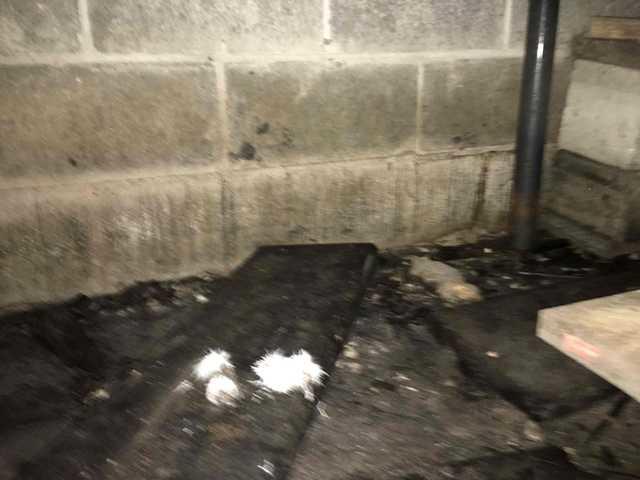
CleanSpace Encapsulation (Before)
In order to prevent water from pooling in the crawlspace from exterior seepage, we installed a full perimeter interior dewatering system with a sump pump. We dug an interior drainage trench system, roughly 12 inches wide throughout the perimeter of the crawlspace. Inside the trenches we laid filter cloth that covers the entire bed of soil and ran the tile to an UtraSump pump. Lastly, we placed a bed of stone over the tile to allow extra drainage and to cover the trench. In order to control excess humidity and moisture in the crawlspace, we installed the Cleanspace an Encapsulation liner. The process of installing the encapsulation membrane is to install the wall liner around the full perimeter of the crawlspace. We used anchors to mechanically fastened the encapsulation liner and to the foundation wall. Next, we applied CleanSpace Encapsulation along the walls and floors of the crawlspace. The point of the encapsulation is to isolate the airspace from the soil as well as the moisture that is caused by temperature change on the foundation. This allows the air space to be conditioned. Finally, an AprilAire full crawlspace dehumidifier was installed in order to extract moisture from the air space, and more importantly the lumber, to prevent mold growth from occurring in the future.
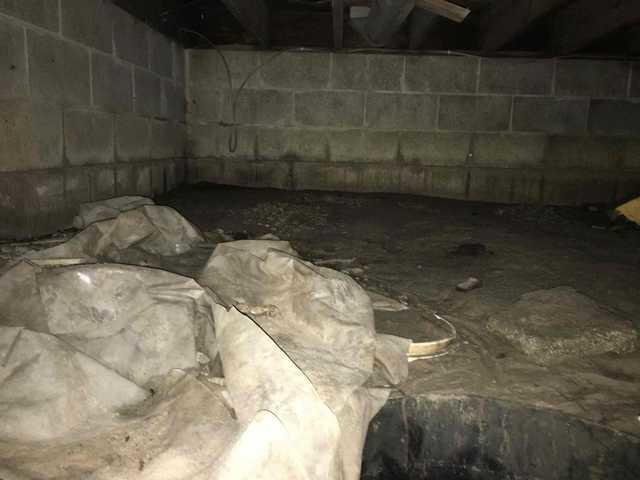
CleanSpace Encapsulation (Before)
In order to prevent water from pooling in the crawlspace from exterior seepage, we installed a full perimeter interior dewatering system with a sump pump. We dug an interior drainage trench system, roughly 12 inches wide throughout the perimeter of the crawlspace. Inside the trenches we laid filter cloth that covers the entire bed of soil and ran the tile to an UtraSump pump. Lastly, we placed a bed of stone over the tile to allow extra drainage and to cover the trench. In order to control excess humidity and moisture in the crawlspace, we installed the Cleanspace an Encapsulation liner. The process of installing the encapsulation membrane is to install the wall liner around the full perimeter of the crawlspace. We used anchors to mechanically fastened the encapsulation liner and to the foundation wall. Next, we applied CleanSpace Encapsulation along the walls and floors of the crawlspace. The point of the encapsulation is to isolate the airspace from the soil as well as the moisture that is caused by temperature change on the foundation. This allows the air space to be conditioned. Finally, an AprilAire full crawlspace dehumidifier was installed in order to extract moisture from the air space, and more importantly the lumber, to prevent mold growth from occurring in the future.
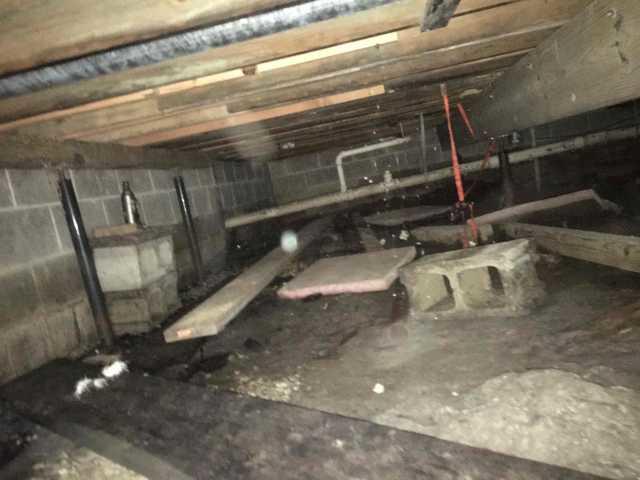
CleanSpace Encapsulation (Before)
In order to prevent water from pooling in the crawlspace from exterior seepage, we installed a full perimeter interior dewatering system with a sump pump. We dug an interior drainage trench system, roughly 12 inches wide throughout the perimeter of the crawlspace. Inside the trenches we laid filter cloth that covers the entire bed of soil and ran the tile to an UtraSump pump. Lastly, we placed a bed of stone over the tile to allow extra drainage and to cover the trench. In order to control excess humidity and moisture in the crawlspace, we installed the Cleanspace an Encapsulation liner. The process of installing the encapsulation membrane is to install the wall liner around the full perimeter of the crawlspace. We used anchors to mechanically fastened the encapsulation liner and to the foundation wall. Next, we applied CleanSpace Encapsulation along the walls and floors of the crawlspace. The point of the encapsulation is to isolate the airspace from the soil as well as the moisture that is caused by temperature change on the foundation. This allows the air space to be conditioned. Finally, an AprilAire full crawlspace dehumidifier was installed in order to extract moisture from the air space, and more importantly the lumber, to prevent mold growth from occurring in the future.
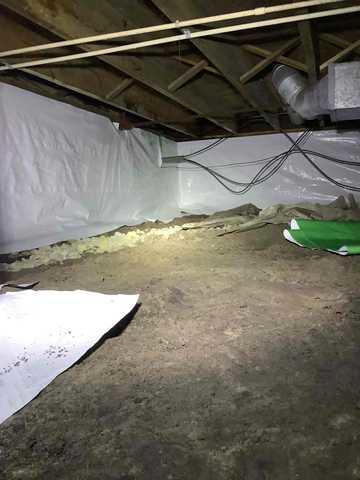
CleanSpace Encapsulation
In order to prevent water from pooling in the crawlspace from exterior seepage, we installed a full perimeter interior dewatering system with a sump pump. We dug an interior drainage trench system, roughly 12 inches wide throughout the perimeter of the crawlspace. Inside the trenches we laid filter cloth that covers the entire bed of soil and ran the tile to an UtraSump pump. Lastly, we placed a bed of stone over the tile to allow extra drainage and to cover the trench. In order to control excess humidity and moisture in the crawlspace, we installed the Cleanspace an Encapsulation liner. The process of installing the encapsulation membrane is to install the wall liner around the full perimeter of the crawlspace. We used anchors to mechanically fastened the encapsulation liner and to the foundation wall. Next, we applied CleanSpace Encapsulation along the walls and floors of the crawlspace. The point of the encapsulation is to isolate the airspace from the soil as well as the moisture that is caused by temperature change on the foundation. This allows the air space to be conditioned. Finally, an AprilAire full crawlspace dehumidifier was installed in order to extract moisture from the air space, and more importantly the lumber, to prevent mold growth from occurring in the future.
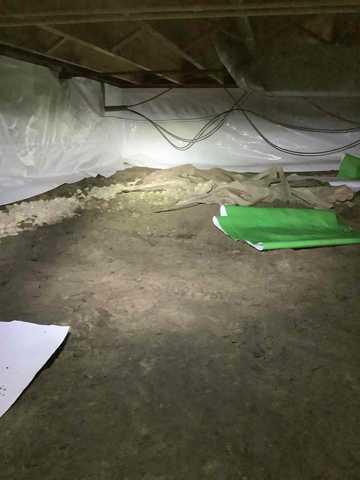
CleanSpace Encapsulation
In order to prevent water from pooling in the crawlspace from exterior seepage, we installed a full perimeter interior dewatering system with a sump pump. We dug an interior drainage trench system, roughly 12 inches wide throughout the perimeter of the crawlspace. Inside the trenches we laid filter cloth that covers the entire bed of soil and ran the tile to an UtraSump pump. Lastly, we placed a bed of stone over the tile to allow extra drainage and to cover the trench. In order to control excess humidity and moisture in the crawlspace, we installed the Cleanspace an Encapsulation liner. The process of installing the encapsulation membrane is to install the wall liner around the full perimeter of the crawlspace. We used anchors to mechanically fastened the encapsulation liner and to the foundation wall. Next, we applied CleanSpace Encapsulation along the walls and floors of the crawlspace. The point of the encapsulation is to isolate the airspace from the soil as well as the moisture that is caused by temperature change on the foundation. This allows the air space to be conditioned. Finally, an AprilAire full crawlspace dehumidifier was installed in order to extract moisture from the air space, and more importantly the lumber, to prevent mold growth from occurring in the future.
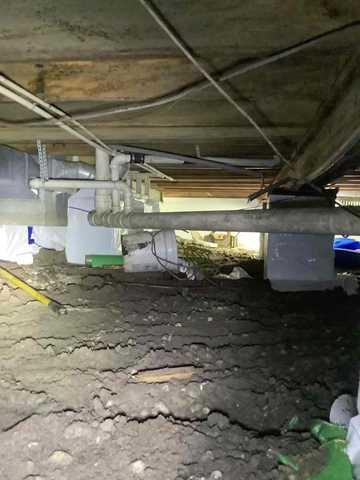
CleanSpace Encapsulation
In order to prevent water from pooling in the crawlspace from exterior seepage, we installed a full perimeter interior dewatering system with a sump pump. We dug an interior drainage trench system, roughly 12 inches wide throughout the perimeter of the crawlspace. Inside the trenches we laid filter cloth that covers the entire bed of soil and ran the tile to an UtraSump pump. Lastly, we placed a bed of stone over the tile to allow extra drainage and to cover the trench. In order to control excess humidity and moisture in the crawlspace, we installed the Cleanspace an Encapsulation liner. The process of installing the encapsulation membrane is to install the wall liner around the full perimeter of the crawlspace. We used anchors to mechanically fastened the encapsulation liner and to the foundation wall. Next, we applied CleanSpace Encapsulation along the walls and floors of the crawlspace. The point of the encapsulation is to isolate the airspace from the soil as well as the moisture that is caused by temperature change on the foundation. This allows the air space to be conditioned. Finally, an AprilAire full crawlspace dehumidifier was installed in order to extract moisture from the air space, and more importantly the lumber, to prevent mold growth from occurring in the future.
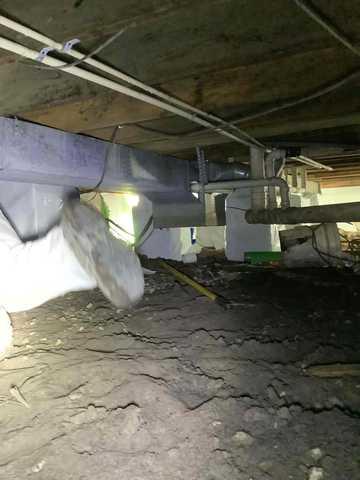
CleanSpace Encapsulation
In order to prevent water from pooling in the crawlspace from exterior seepage, we installed a full perimeter interior dewatering system with a sump pump. We dug an interior drainage trench system, roughly 12 inches wide throughout the perimeter of the crawlspace. Inside the trenches we laid filter cloth that covers the entire bed of soil and ran the tile to an UtraSump pump. Lastly, we placed a bed of stone over the tile to allow extra drainage and to cover the trench. In order to control excess humidity and moisture in the crawlspace, we installed the Cleanspace an Encapsulation liner. The process of installing the encapsulation membrane is to install the wall liner around the full perimeter of the crawlspace. We used anchors to mechanically fastened the encapsulation liner and to the foundation wall. Next, we applied CleanSpace Encapsulation along the walls and floors of the crawlspace. The point of the encapsulation is to isolate the airspace from the soil as well as the moisture that is caused by temperature change on the foundation. This allows the air space to be conditioned. Finally, an AprilAire full crawlspace dehumidifier was installed in order to extract moisture from the air space, and more importantly the lumber, to prevent mold growth from occurring in the future.

CleanSpace Encapsulation
In order to prevent water from pooling in the crawlspace from exterior seepage, we installed a full perimeter interior dewatering system with a sump pump. We dug an interior drainage trench system, roughly 12 inches wide throughout the perimeter of the crawlspace. Inside the trenches we laid filter cloth that covers the entire bed of soil and ran the tile to an UtraSump pump. Lastly, we placed a bed of stone over the tile to allow extra drainage and to cover the trench. In order to control excess humidity and moisture in the crawlspace, we installed the Cleanspace an Encapsulation liner. The process of installing the encapsulation membrane is to install the wall liner around the full perimeter of the crawlspace. We used anchors to mechanically fastened the encapsulation liner and to the foundation wall. Next, we applied CleanSpace Encapsulation along the walls and floors of the crawlspace. The point of the encapsulation is to isolate the airspace from the soil as well as the moisture that is caused by temperature change on the foundation. This allows the air space to be conditioned. Finally, an AprilAire full crawlspace dehumidifier was installed in order to extract moisture from the air space, and more importantly the lumber, to prevent mold growth from occurring in the future.
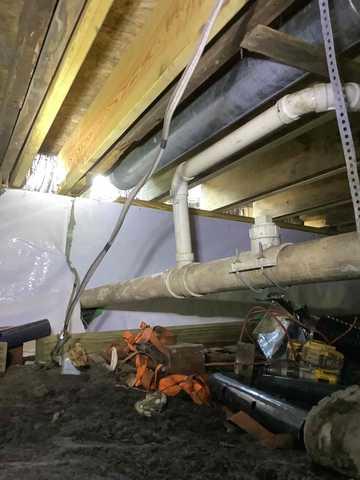
CleanSpace Encapsulation
In order to prevent water from pooling in the crawlspace from exterior seepage, we installed a full perimeter interior dewatering system with a sump pump. We dug an interior drainage trench system, roughly 12 inches wide throughout the perimeter of the crawlspace. Inside the trenches we laid filter cloth that covers the entire bed of soil and ran the tile to an UtraSump pump. Lastly, we placed a bed of stone over the tile to allow extra drainage and to cover the trench. In order to control excess humidity and moisture in the crawlspace, we installed the Cleanspace an Encapsulation liner. The process of installing the encapsulation membrane is to install the wall liner around the full perimeter of the crawlspace. We used anchors to mechanically fastened the encapsulation liner and to the foundation wall. Next, we applied CleanSpace Encapsulation along the walls and floors of the crawlspace. The point of the encapsulation is to isolate the airspace from the soil as well as the moisture that is caused by temperature change on the foundation. This allows the air space to be conditioned. Finally, an AprilAire full crawlspace dehumidifier was installed in order to extract moisture from the air space, and more importantly the lumber, to prevent mold growth from occurring in the future.
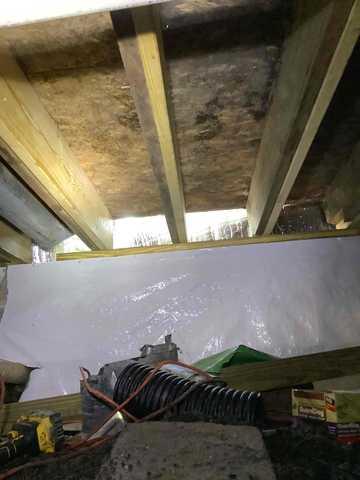
CleanSpace Encapsulation
In order to prevent water from pooling in the crawlspace from exterior seepage, we installed a full perimeter interior dewatering system with a sump pump. We dug an interior drainage trench system, roughly 12 inches wide throughout the perimeter of the crawlspace. Inside the trenches we laid filter cloth that covers the entire bed of soil and ran the tile to an UtraSump pump. Lastly, we placed a bed of stone over the tile to allow extra drainage and to cover the trench. In order to control excess humidity and moisture in the crawlspace, we installed the Cleanspace an Encapsulation liner. The process of installing the encapsulation membrane is to install the wall liner around the full perimeter of the crawlspace. We used anchors to mechanically fastened the encapsulation liner and to the foundation wall. Next, we applied CleanSpace Encapsulation along the walls and floors of the crawlspace. The point of the encapsulation is to isolate the airspace from the soil as well as the moisture that is caused by temperature change on the foundation. This allows the air space to be conditioned. Finally, an AprilAire full crawlspace dehumidifier was installed in order to extract moisture from the air space, and more importantly the lumber, to prevent mold growth from occurring in the future.
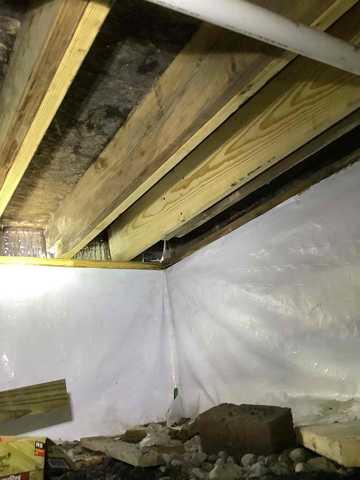
CleanSpace Encapsulation
In order to prevent water from pooling in the crawlspace from exterior seepage, we installed a full perimeter interior dewatering system with a sump pump. We dug an interior drainage trench system, roughly 12 inches wide throughout the perimeter of the crawlspace. Inside the trenches we laid filter cloth that covers the entire bed of soil and ran the tile to an UtraSump pump. Lastly, we placed a bed of stone over the tile to allow extra drainage and to cover the trench. In order to control excess humidity and moisture in the crawlspace, we installed the Cleanspace an Encapsulation liner. The process of installing the encapsulation membrane is to install the wall liner around the full perimeter of the crawlspace. We used anchors to mechanically fastened the encapsulation liner and to the foundation wall. Next, we applied CleanSpace Encapsulation along the walls and floors of the crawlspace. The point of the encapsulation is to isolate the airspace from the soil as well as the moisture that is caused by temperature change on the foundation. This allows the air space to be conditioned. Finally, an AprilAire full crawlspace dehumidifier was installed in order to extract moisture from the air space, and more importantly the lumber, to prevent mold growth from occurring in the future.
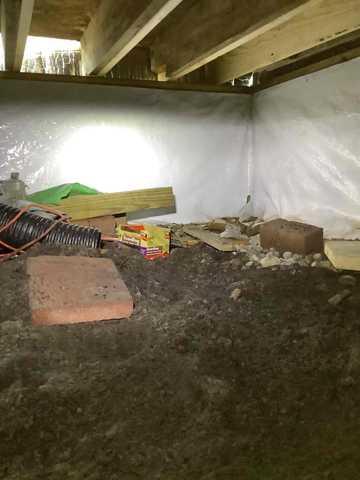
CleanSpace Encapsulation
In order to prevent water from pooling in the crawlspace from exterior seepage, we installed a full perimeter interior dewatering system with a sump pump. We dug an interior drainage trench system, roughly 12 inches wide throughout the perimeter of the crawlspace. Inside the trenches we laid filter cloth that covers the entire bed of soil and ran the tile to an UtraSump pump. Lastly, we placed a bed of stone over the tile to allow extra drainage and to cover the trench. In order to control excess humidity and moisture in the crawlspace, we installed the Cleanspace an Encapsulation liner. The process of installing the encapsulation membrane is to install the wall liner around the full perimeter of the crawlspace. We used anchors to mechanically fastened the encapsulation liner and to the foundation wall. Next, we applied CleanSpace Encapsulation along the walls and floors of the crawlspace. The point of the encapsulation is to isolate the airspace from the soil as well as the moisture that is caused by temperature change on the foundation. This allows the air space to be conditioned. Finally, an AprilAire full crawlspace dehumidifier was installed in order to extract moisture from the air space, and more importantly the lumber, to prevent mold growth from occurring in the future.
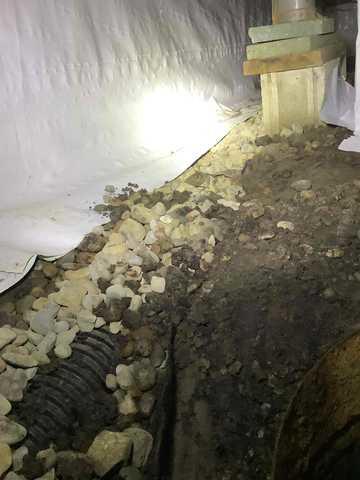
CleanSpace Encapsulation
In order to prevent water from pooling in the crawlspace from exterior seepage, we installed a full perimeter interior dewatering system with a sump pump. We dug an interior drainage trench system, roughly 12 inches wide throughout the perimeter of the crawlspace. Inside the trenches we laid filter cloth that covers the entire bed of soil and ran the tile to an UtraSump pump. Lastly, we placed a bed of stone over the tile to allow extra drainage and to cover the trench. In order to control excess humidity and moisture in the crawlspace, we installed the Cleanspace an Encapsulation liner. The process of installing the encapsulation membrane is to install the wall liner around the full perimeter of the crawlspace. We used anchors to mechanically fastened the encapsulation liner and to the foundation wall. Next, we applied CleanSpace Encapsulation along the walls and floors of the crawlspace. The point of the encapsulation is to isolate the airspace from the soil as well as the moisture that is caused by temperature change on the foundation. This allows the air space to be conditioned. Finally, an AprilAire full crawlspace dehumidifier was installed in order to extract moisture from the air space, and more importantly the lumber, to prevent mold growth from occurring in the future.

CleanSpace Encapsulation
In order to prevent water from pooling in the crawlspace from exterior seepage, we installed a full perimeter interior dewatering system with a sump pump. We dug an interior drainage trench system, roughly 12 inches wide throughout the perimeter of the crawlspace. Inside the trenches we laid filter cloth that covers the entire bed of soil and ran the tile to an UtraSump pump. Lastly, we placed a bed of stone over the tile to allow extra drainage and to cover the trench. In order to control excess humidity and moisture in the crawlspace, we installed the Cleanspace an Encapsulation liner. The process of installing the encapsulation membrane is to install the wall liner around the full perimeter of the crawlspace. We used anchors to mechanically fastened the encapsulation liner and to the foundation wall. Next, we applied CleanSpace Encapsulation along the walls and floors of the crawlspace. The point of the encapsulation is to isolate the airspace from the soil as well as the moisture that is caused by temperature change on the foundation. This allows the air space to be conditioned. Finally, an AprilAire full crawlspace dehumidifier was installed in order to extract moisture from the air space, and more importantly the lumber, to prevent mold growth from occurring in the future.

CleanSpace Encapsulation
In order to prevent water from pooling in the crawlspace from exterior seepage, we installed a full perimeter interior dewatering system with a sump pump. We dug an interior drainage trench system, roughly 12 inches wide throughout the perimeter of the crawlspace. Inside the trenches we laid filter cloth that covers the entire bed of soil and ran the tile to an UtraSump pump. Lastly, we placed a bed of stone over the tile to allow extra drainage and to cover the trench. In order to control excess humidity and moisture in the crawlspace, we installed the Cleanspace an Encapsulation liner. The process of installing the encapsulation membrane is to install the wall liner around the full perimeter of the crawlspace. We used anchors to mechanically fastened the encapsulation liner and to the foundation wall. Next, we applied CleanSpace Encapsulation along the walls and floors of the crawlspace. The point of the encapsulation is to isolate the airspace from the soil as well as the moisture that is caused by temperature change on the foundation. This allows the air space to be conditioned. Finally, an AprilAire full crawlspace dehumidifier was installed in order to extract moisture from the air space, and more importantly the lumber, to prevent mold growth from occurring in the future.

CleanSpace Encapsulation
In order to prevent water from pooling in the crawlspace from exterior seepage, we installed a full perimeter interior dewatering system with a sump pump. We dug an interior drainage trench system, roughly 12 inches wide throughout the perimeter of the crawlspace. Inside the trenches we laid filter cloth that covers the entire bed of soil and ran the tile to an UtraSump pump. Lastly, we placed a bed of stone over the tile to allow extra drainage and to cover the trench. In order to control excess humidity and moisture in the crawlspace, we installed the Cleanspace an Encapsulation liner. The process of installing the encapsulation membrane is to install the wall liner around the full perimeter of the crawlspace. We used anchors to mechanically fastened the encapsulation liner and to the foundation wall. Next, we applied CleanSpace Encapsulation along the walls and floors of the crawlspace. The point of the encapsulation is to isolate the airspace from the soil as well as the moisture that is caused by temperature change on the foundation. This allows the air space to be conditioned. Finally, an AprilAire full crawlspace dehumidifier was installed in order to extract moisture from the air space, and more importantly the lumber, to prevent mold growth from occurring in the future.

CleanSpace Encapsulation
In order to prevent water from pooling in the crawlspace from exterior seepage, we installed a full perimeter interior dewatering system with a sump pump. We dug an interior drainage trench system, roughly 12 inches wide throughout the perimeter of the crawlspace. Inside the trenches we laid filter cloth that covers the entire bed of soil and ran the tile to an UtraSump pump. Lastly, we placed a bed of stone over the tile to allow extra drainage and to cover the trench. In order to control excess humidity and moisture in the crawlspace, we installed the Cleanspace an Encapsulation liner. The process of installing the encapsulation membrane is to install the wall liner around the full perimeter of the crawlspace. We used anchors to mechanically fastened the encapsulation liner and to the foundation wall. Next, we applied CleanSpace Encapsulation along the walls and floors of the crawlspace. The point of the encapsulation is to isolate the airspace from the soil as well as the moisture that is caused by temperature change on the foundation. This allows the air space to be conditioned. Finally, an AprilAire full crawlspace dehumidifier was installed in order to extract moisture from the air space, and more importantly the lumber, to prevent mold growth from occurring in the future.
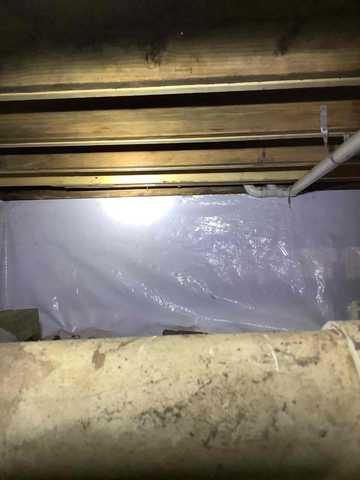
CleanSpace Encapsulation
In order to prevent water from pooling in the crawlspace from exterior seepage, we installed a full perimeter interior dewatering system with a sump pump. We dug an interior drainage trench system, roughly 12 inches wide throughout the perimeter of the crawlspace. Inside the trenches we laid filter cloth that covers the entire bed of soil and ran the tile to an UtraSump pump. Lastly, we placed a bed of stone over the tile to allow extra drainage and to cover the trench. In order to control excess humidity and moisture in the crawlspace, we installed the Cleanspace an Encapsulation liner. The process of installing the encapsulation membrane is to install the wall liner around the full perimeter of the crawlspace. We used anchors to mechanically fastened the encapsulation liner and to the foundation wall. Next, we applied CleanSpace Encapsulation along the walls and floors of the crawlspace. The point of the encapsulation is to isolate the airspace from the soil as well as the moisture that is caused by temperature change on the foundation. This allows the air space to be conditioned. Finally, an AprilAire full crawlspace dehumidifier was installed in order to extract moisture from the air space, and more importantly the lumber, to prevent mold growth from occurring in the future.
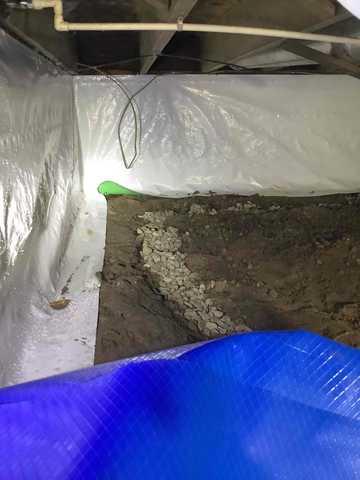
CleanSpace Encapsulation
In order to prevent water from pooling in the crawlspace from exterior seepage, we installed a full perimeter interior dewatering system with a sump pump. We dug an interior drainage trench system, roughly 12 inches wide throughout the perimeter of the crawlspace. Inside the trenches we laid filter cloth that covers the entire bed of soil and ran the tile to an UtraSump pump. Lastly, we placed a bed of stone over the tile to allow extra drainage and to cover the trench. In order to control excess humidity and moisture in the crawlspace, we installed the Cleanspace an Encapsulation liner. The process of installing the encapsulation membrane is to install the wall liner around the full perimeter of the crawlspace. We used anchors to mechanically fastened the encapsulation liner and to the foundation wall. Next, we applied CleanSpace Encapsulation along the walls and floors of the crawlspace. The point of the encapsulation is to isolate the airspace from the soil as well as the moisture that is caused by temperature change on the foundation. This allows the air space to be conditioned. Finally, an AprilAire full crawlspace dehumidifier was installed in order to extract moisture from the air space, and more importantly the lumber, to prevent mold growth from occurring in the future.
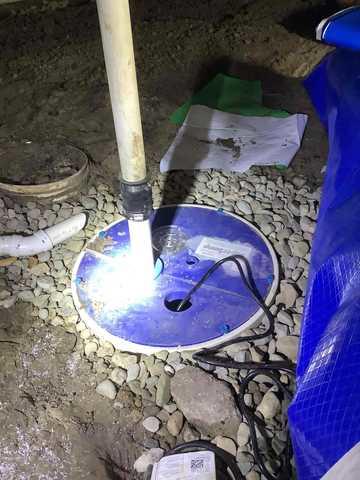
CleanSpace Encapsulation
In order to prevent water from pooling in the crawlspace from exterior seepage, we installed a full perimeter interior dewatering system with a sump pump. We dug an interior drainage trench system, roughly 12 inches wide throughout the perimeter of the crawlspace. Inside the trenches we laid filter cloth that covers the entire bed of soil and ran the tile to an UtraSump pump. Lastly, we placed a bed of stone over the tile to allow extra drainage and to cover the trench. In order to control excess humidity and moisture in the crawlspace, we installed the Cleanspace an Encapsulation liner. The process of installing the encapsulation membrane is to install the wall liner around the full perimeter of the crawlspace. We used anchors to mechanically fastened the encapsulation liner and to the foundation wall. Next, we applied CleanSpace Encapsulation along the walls and floors of the crawlspace. The point of the encapsulation is to isolate the airspace from the soil as well as the moisture that is caused by temperature change on the foundation. This allows the air space to be conditioned. Finally, an AprilAire full crawlspace dehumidifier was installed in order to extract moisture from the air space, and more importantly the lumber, to prevent mold growth from occurring in the future.
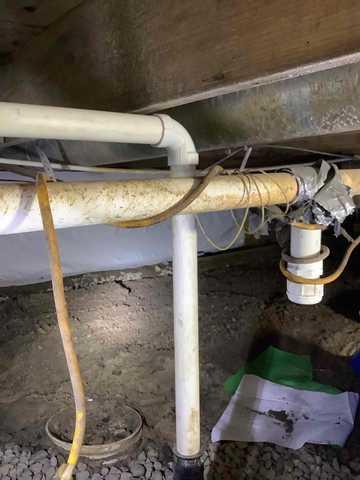
CleanSpace Encapsulation
In order to prevent water from pooling in the crawlspace from exterior seepage, we installed a full perimeter interior dewatering system with a sump pump. We dug an interior drainage trench system, roughly 12 inches wide throughout the perimeter of the crawlspace. Inside the trenches we laid filter cloth that covers the entire bed of soil and ran the tile to an UtraSump pump. Lastly, we placed a bed of stone over the tile to allow extra drainage and to cover the trench. In order to control excess humidity and moisture in the crawlspace, we installed the Cleanspace an Encapsulation liner. The process of installing the encapsulation membrane is to install the wall liner around the full perimeter of the crawlspace. We used anchors to mechanically fastened the encapsulation liner and to the foundation wall. Next, we applied CleanSpace Encapsulation along the walls and floors of the crawlspace. The point of the encapsulation is to isolate the airspace from the soil as well as the moisture that is caused by temperature change on the foundation. This allows the air space to be conditioned. Finally, an AprilAire full crawlspace dehumidifier was installed in order to extract moisture from the air space, and more importantly the lumber, to prevent mold growth from occurring in the future.
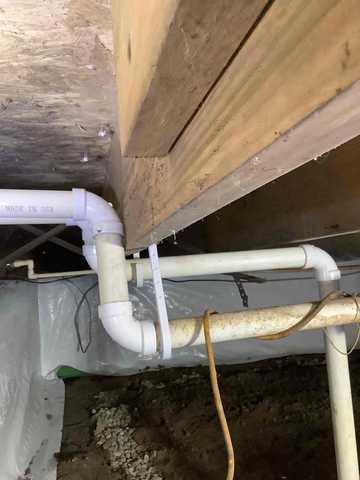
CleanSpace Encapsulation
In order to prevent water from pooling in the crawlspace from exterior seepage, we installed a full perimeter interior dewatering system with a sump pump. We dug an interior drainage trench system, roughly 12 inches wide throughout the perimeter of the crawlspace. Inside the trenches we laid filter cloth that covers the entire bed of soil and ran the tile to an UtraSump pump. Lastly, we placed a bed of stone over the tile to allow extra drainage and to cover the trench. In order to control excess humidity and moisture in the crawlspace, we installed the Cleanspace an Encapsulation liner. The process of installing the encapsulation membrane is to install the wall liner around the full perimeter of the crawlspace. We used anchors to mechanically fastened the encapsulation liner and to the foundation wall. Next, we applied CleanSpace Encapsulation along the walls and floors of the crawlspace. The point of the encapsulation is to isolate the airspace from the soil as well as the moisture that is caused by temperature change on the foundation. This allows the air space to be conditioned. Finally, an AprilAire full crawlspace dehumidifier was installed in order to extract moisture from the air space, and more importantly the lumber, to prevent mold growth from occurring in the future.
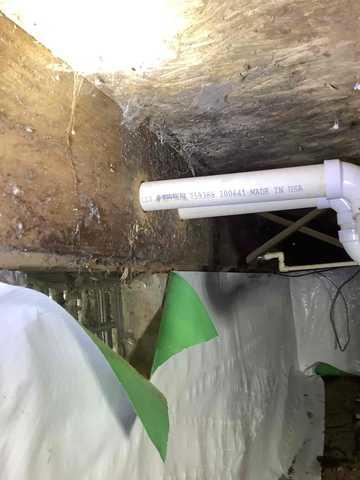
CleanSpace Encapsulation
In order to prevent water from pooling in the crawlspace from exterior seepage, we installed a full perimeter interior dewatering system with a sump pump. We dug an interior drainage trench system, roughly 12 inches wide throughout the perimeter of the crawlspace. Inside the trenches we laid filter cloth that covers the entire bed of soil and ran the tile to an UtraSump pump. Lastly, we placed a bed of stone over the tile to allow extra drainage and to cover the trench. In order to control excess humidity and moisture in the crawlspace, we installed the Cleanspace an Encapsulation liner. The process of installing the encapsulation membrane is to install the wall liner around the full perimeter of the crawlspace. We used anchors to mechanically fastened the encapsulation liner and to the foundation wall. Next, we applied CleanSpace Encapsulation along the walls and floors of the crawlspace. The point of the encapsulation is to isolate the airspace from the soil as well as the moisture that is caused by temperature change on the foundation. This allows the air space to be conditioned. Finally, an AprilAire full crawlspace dehumidifier was installed in order to extract moisture from the air space, and more importantly the lumber, to prevent mold growth from occurring in the future.
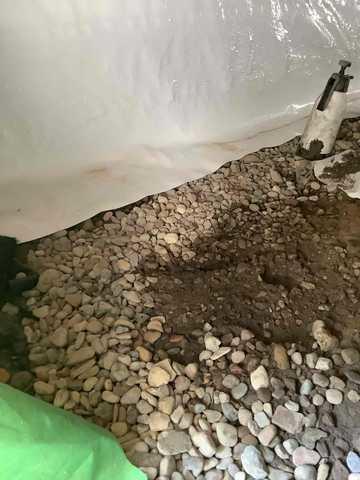
CleanSpace Encapsulation
In order to prevent water from pooling in the crawlspace from exterior seepage, we installed a full perimeter interior dewatering system with a sump pump. We dug an interior drainage trench system, roughly 12 inches wide throughout the perimeter of the crawlspace. Inside the trenches we laid filter cloth that covers the entire bed of soil and ran the tile to an UtraSump pump. Lastly, we placed a bed of stone over the tile to allow extra drainage and to cover the trench. In order to control excess humidity and moisture in the crawlspace, we installed the Cleanspace an Encapsulation liner. The process of installing the encapsulation membrane is to install the wall liner around the full perimeter of the crawlspace. We used anchors to mechanically fastened the encapsulation liner and to the foundation wall. Next, we applied CleanSpace Encapsulation along the walls and floors of the crawlspace. The point of the encapsulation is to isolate the airspace from the soil as well as the moisture that is caused by temperature change on the foundation. This allows the air space to be conditioned. Finally, an AprilAire full crawlspace dehumidifier was installed in order to extract moisture from the air space, and more importantly the lumber, to prevent mold growth from occurring in the future.
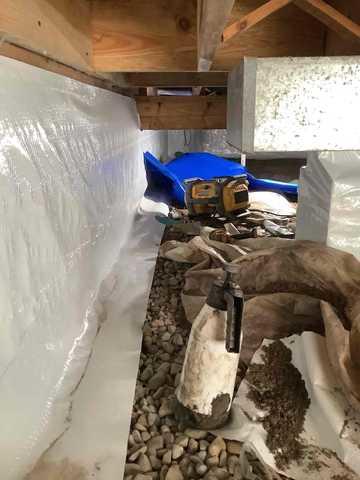
CleanSpace Encapsulation
In order to prevent water from pooling in the crawlspace from exterior seepage, we installed a full perimeter interior dewatering system with a sump pump. We dug an interior drainage trench system, roughly 12 inches wide throughout the perimeter of the crawlspace. Inside the trenches we laid filter cloth that covers the entire bed of soil and ran the tile to an UtraSump pump. Lastly, we placed a bed of stone over the tile to allow extra drainage and to cover the trench. In order to control excess humidity and moisture in the crawlspace, we installed the Cleanspace an Encapsulation liner. The process of installing the encapsulation membrane is to install the wall liner around the full perimeter of the crawlspace. We used anchors to mechanically fastened the encapsulation liner and to the foundation wall. Next, we applied CleanSpace Encapsulation along the walls and floors of the crawlspace. The point of the encapsulation is to isolate the airspace from the soil as well as the moisture that is caused by temperature change on the foundation. This allows the air space to be conditioned. Finally, an AprilAire full crawlspace dehumidifier was installed in order to extract moisture from the air space, and more importantly the lumber, to prevent mold growth from occurring in the future.
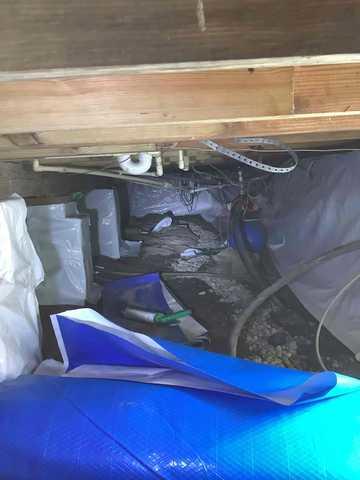
CleanSpace Encapsulation
In order to prevent water from pooling in the crawlspace from exterior seepage, we installed a full perimeter interior dewatering system with a sump pump. We dug an interior drainage trench system, roughly 12 inches wide throughout the perimeter of the crawlspace. Inside the trenches we laid filter cloth that covers the entire bed of soil and ran the tile to an UtraSump pump. Lastly, we placed a bed of stone over the tile to allow extra drainage and to cover the trench. In order to control excess humidity and moisture in the crawlspace, we installed the Cleanspace an Encapsulation liner. The process of installing the encapsulation membrane is to install the wall liner around the full perimeter of the crawlspace. We used anchors to mechanically fastened the encapsulation liner and to the foundation wall. Next, we applied CleanSpace Encapsulation along the walls and floors of the crawlspace. The point of the encapsulation is to isolate the airspace from the soil as well as the moisture that is caused by temperature change on the foundation. This allows the air space to be conditioned. Finally, an AprilAire full crawlspace dehumidifier was installed in order to extract moisture from the air space, and more importantly the lumber, to prevent mold growth from occurring in the future.
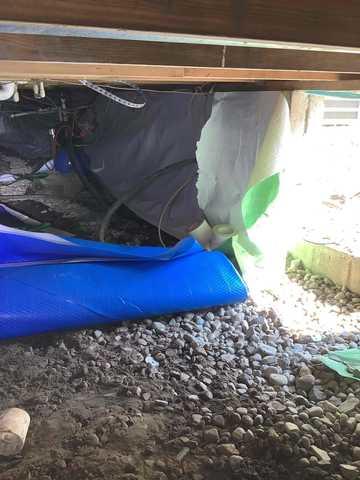
CleanSpace Encapsulation
In order to prevent water from pooling in the crawlspace from exterior seepage, we installed a full perimeter interior dewatering system with a sump pump. We dug an interior drainage trench system, roughly 12 inches wide throughout the perimeter of the crawlspace. Inside the trenches we laid filter cloth that covers the entire bed of soil and ran the tile to an UtraSump pump. Lastly, we placed a bed of stone over the tile to allow extra drainage and to cover the trench. In order to control excess humidity and moisture in the crawlspace, we installed the Cleanspace an Encapsulation liner. The process of installing the encapsulation membrane is to install the wall liner around the full perimeter of the crawlspace. We used anchors to mechanically fastened the encapsulation liner and to the foundation wall. Next, we applied CleanSpace Encapsulation along the walls and floors of the crawlspace. The point of the encapsulation is to isolate the airspace from the soil as well as the moisture that is caused by temperature change on the foundation. This allows the air space to be conditioned. Finally, an AprilAire full crawlspace dehumidifier was installed in order to extract moisture from the air space, and more importantly the lumber, to prevent mold growth from occurring in the future.

CleanSpace Encapsulation
In order to prevent water from pooling in the crawlspace from exterior seepage, we installed a full perimeter interior dewatering system with a sump pump. We dug an interior drainage trench system, roughly 12 inches wide throughout the perimeter of the crawlspace. Inside the trenches we laid filter cloth that covers the entire bed of soil and ran the tile to an UtraSump pump. Lastly, we placed a bed of stone over the tile to allow extra drainage and to cover the trench. In order to control excess humidity and moisture in the crawlspace, we installed the Cleanspace an Encapsulation liner. The process of installing the encapsulation membrane is to install the wall liner around the full perimeter of the crawlspace. We used anchors to mechanically fastened the encapsulation liner and to the foundation wall. Next, we applied CleanSpace Encapsulation along the walls and floors of the crawlspace. The point of the encapsulation is to isolate the airspace from the soil as well as the moisture that is caused by temperature change on the foundation. This allows the air space to be conditioned. Finally, an AprilAire full crawlspace dehumidifier was installed in order to extract moisture from the air space, and more importantly the lumber, to prevent mold growth from occurring in the future.
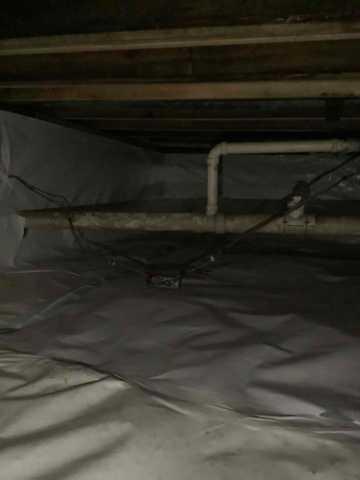
CleanSpace Encapsulation
In order to prevent water from pooling in the crawlspace from exterior seepage, we installed a full perimeter interior dewatering system with a sump pump. We dug an interior drainage trench system, roughly 12 inches wide throughout the perimeter of the crawlspace. Inside the trenches we laid filter cloth that covers the entire bed of soil and ran the tile to an UtraSump pump. Lastly, we placed a bed of stone over the tile to allow extra drainage and to cover the trench. In order to control excess humidity and moisture in the crawlspace, we installed the Cleanspace an Encapsulation liner. The process of installing the encapsulation membrane is to install the wall liner around the full perimeter of the crawlspace. We used anchors to mechanically fastened the encapsulation liner and to the foundation wall. Next, we applied CleanSpace Encapsulation along the walls and floors of the crawlspace. The point of the encapsulation is to isolate the airspace from the soil as well as the moisture that is caused by temperature change on the foundation. This allows the air space to be conditioned. Finally, an AprilAire full crawlspace dehumidifier was installed in order to extract moisture from the air space, and more importantly the lumber, to prevent mold growth from occurring in the future.
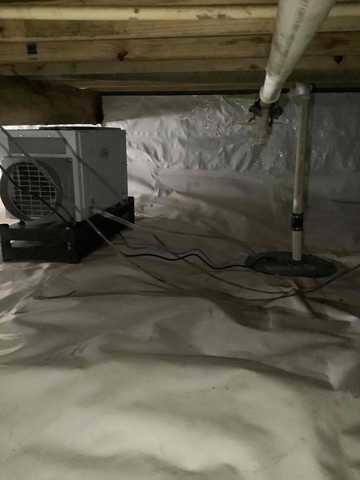
CleanSpace Encapsulation
In order to prevent water from pooling in the crawlspace from exterior seepage, we installed a full perimeter interior dewatering system with a sump pump. We dug an interior drainage trench system, roughly 12 inches wide throughout the perimeter of the crawlspace. Inside the trenches we laid filter cloth that covers the entire bed of soil and ran the tile to an UtraSump pump. Lastly, we placed a bed of stone over the tile to allow extra drainage and to cover the trench. In order to control excess humidity and moisture in the crawlspace, we installed the Cleanspace an Encapsulation liner. The process of installing the encapsulation membrane is to install the wall liner around the full perimeter of the crawlspace. We used anchors to mechanically fastened the encapsulation liner and to the foundation wall. Next, we applied CleanSpace Encapsulation along the walls and floors of the crawlspace. The point of the encapsulation is to isolate the airspace from the soil as well as the moisture that is caused by temperature change on the foundation. This allows the air space to be conditioned. Finally, an AprilAire full crawlspace dehumidifier was installed in order to extract moisture from the air space, and more importantly the lumber, to prevent mold growth from occurring in the future.
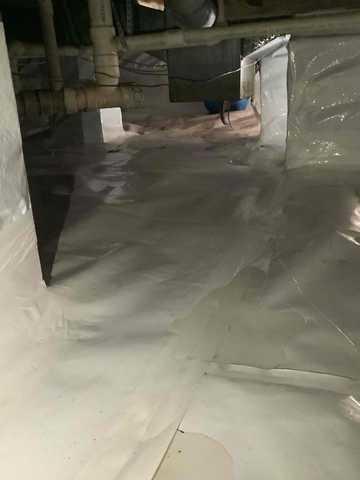
CleanSpace Encapsulation
In order to prevent water from pooling in the crawlspace from exterior seepage, we installed a full perimeter interior dewatering system with a sump pump. We dug an interior drainage trench system, roughly 12 inches wide throughout the perimeter of the crawlspace. Inside the trenches we laid filter cloth that covers the entire bed of soil and ran the tile to an UtraSump pump. Lastly, we placed a bed of stone over the tile to allow extra drainage and to cover the trench. In order to control excess humidity and moisture in the crawlspace, we installed the Cleanspace an Encapsulation liner. The process of installing the encapsulation membrane is to install the wall liner around the full perimeter of the crawlspace. We used anchors to mechanically fastened the encapsulation liner and to the foundation wall. Next, we applied CleanSpace Encapsulation along the walls and floors of the crawlspace. The point of the encapsulation is to isolate the airspace from the soil as well as the moisture that is caused by temperature change on the foundation. This allows the air space to be conditioned. Finally, an AprilAire full crawlspace dehumidifier was installed in order to extract moisture from the air space, and more importantly the lumber, to prevent mold growth from occurring in the future.
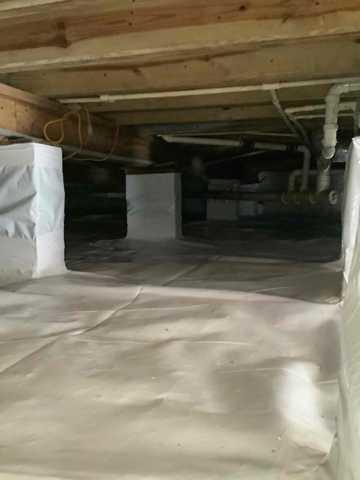
CleanSpace Encapsulation
In order to prevent water from pooling in the crawlspace from exterior seepage, we installed a full perimeter interior dewatering system with a sump pump. We dug an interior drainage trench system, roughly 12 inches wide throughout the perimeter of the crawlspace. Inside the trenches we laid filter cloth that covers the entire bed of soil and ran the tile to an UtraSump pump. Lastly, we placed a bed of stone over the tile to allow extra drainage and to cover the trench. In order to control excess humidity and moisture in the crawlspace, we installed the Cleanspace an Encapsulation liner. The process of installing the encapsulation membrane is to install the wall liner around the full perimeter of the crawlspace. We used anchors to mechanically fastened the encapsulation liner and to the foundation wall. Next, we applied CleanSpace Encapsulation along the walls and floors of the crawlspace. The point of the encapsulation is to isolate the airspace from the soil as well as the moisture that is caused by temperature change on the foundation. This allows the air space to be conditioned. Finally, an AprilAire full crawlspace dehumidifier was installed in order to extract moisture from the air space, and more importantly the lumber, to prevent mold growth from occurring in the future.
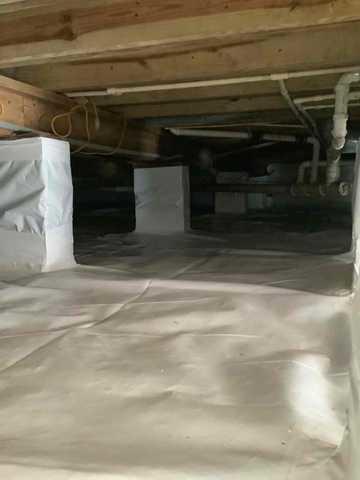
CleanSpace Encapsulation
In order to prevent water from pooling in the crawlspace from exterior seepage, we installed a full perimeter interior dewatering system with a sump pump. We dug an interior drainage trench system, roughly 12 inches wide throughout the perimeter of the crawlspace. Inside the trenches we laid filter cloth that covers the entire bed of soil and ran the tile to an UtraSump pump. Lastly, we placed a bed of stone over the tile to allow extra drainage and to cover the trench. In order to control excess humidity and moisture in the crawlspace, we installed the Cleanspace an Encapsulation liner. The process of installing the encapsulation membrane is to install the wall liner around the full perimeter of the crawlspace. We used anchors to mechanically fastened the encapsulation liner and to the foundation wall. Next, we applied CleanSpace Encapsulation along the walls and floors of the crawlspace. The point of the encapsulation is to isolate the airspace from the soil as well as the moisture that is caused by temperature change on the foundation. This allows the air space to be conditioned. Finally, an AprilAire full crawlspace dehumidifier was installed in order to extract moisture from the air space, and more importantly the lumber, to prevent mold growth from occurring in the future.
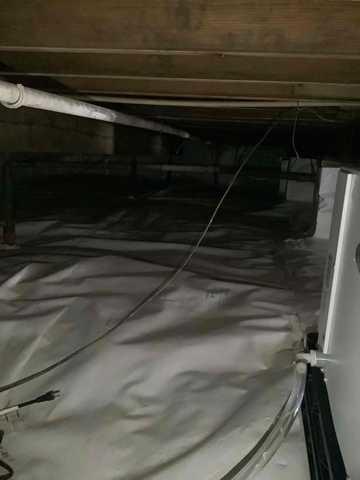
CleanSpace Encapsulation
In order to prevent water from pooling in the crawlspace from exterior seepage, we installed a full perimeter interior dewatering system with a sump pump. We dug an interior drainage trench system, roughly 12 inches wide throughout the perimeter of the crawlspace. Inside the trenches we laid filter cloth that covers the entire bed of soil and ran the tile to an UtraSump pump. Lastly, we placed a bed of stone over the tile to allow extra drainage and to cover the trench. In order to control excess humidity and moisture in the crawlspace, we installed the Cleanspace an Encapsulation liner. The process of installing the encapsulation membrane is to install the wall liner around the full perimeter of the crawlspace. We used anchors to mechanically fastened the encapsulation liner and to the foundation wall. Next, we applied CleanSpace Encapsulation along the walls and floors of the crawlspace. The point of the encapsulation is to isolate the airspace from the soil as well as the moisture that is caused by temperature change on the foundation. This allows the air space to be conditioned. Finally, an AprilAire full crawlspace dehumidifier was installed in order to extract moisture from the air space, and more importantly the lumber, to prevent mold growth from occurring in the future.

CleanSpace Encapsulation
In order to prevent water from pooling in the crawlspace from exterior seepage, we installed a full perimeter interior dewatering system with a sump pump. We dug an interior drainage trench system, roughly 12 inches wide throughout the perimeter of the crawlspace. Inside the trenches we laid filter cloth that covers the entire bed of soil and ran the tile to an UtraSump pump. Lastly, we placed a bed of stone over the tile to allow extra drainage and to cover the trench. In order to control excess humidity and moisture in the crawlspace, we installed the Cleanspace an Encapsulation liner. The process of installing the encapsulation membrane is to install the wall liner around the full perimeter of the crawlspace. We used anchors to mechanically fastened the encapsulation liner and to the foundation wall. Next, we applied CleanSpace Encapsulation along the walls and floors of the crawlspace. The point of the encapsulation is to isolate the airspace from the soil as well as the moisture that is caused by temperature change on the foundation. This allows the air space to be conditioned. Finally, an AprilAire full crawlspace dehumidifier was installed in order to extract moisture from the air space, and more importantly the lumber, to prevent mold growth from occurring in the future.
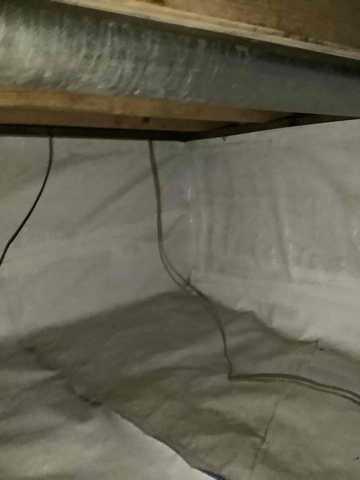
CleanSpace Encapsulation
In order to prevent water from pooling in the crawlspace from exterior seepage, we installed a full perimeter interior dewatering system with a sump pump. We dug an interior drainage trench system, roughly 12 inches wide throughout the perimeter of the crawlspace. Inside the trenches we laid filter cloth that covers the entire bed of soil and ran the tile to an UtraSump pump. Lastly, we placed a bed of stone over the tile to allow extra drainage and to cover the trench. In order to control excess humidity and moisture in the crawlspace, we installed the Cleanspace an Encapsulation liner. The process of installing the encapsulation membrane is to install the wall liner around the full perimeter of the crawlspace. We used anchors to mechanically fastened the encapsulation liner and to the foundation wall. Next, we applied CleanSpace Encapsulation along the walls and floors of the crawlspace. The point of the encapsulation is to isolate the airspace from the soil as well as the moisture that is caused by temperature change on the foundation. This allows the air space to be conditioned. Finally, an AprilAire full crawlspace dehumidifier was installed in order to extract moisture from the air space, and more importantly the lumber, to prevent mold growth from occurring in the future.
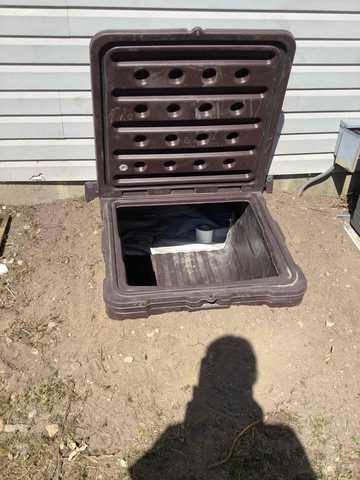
CleanSpace Encapsulation
In order to prevent water from pooling in the crawlspace from exterior seepage, we installed a full perimeter interior dewatering system with a sump pump. We dug an interior drainage trench system, roughly 12 inches wide throughout the perimeter of the crawlspace. Inside the trenches we laid filter cloth that covers the entire bed of soil and ran the tile to an UtraSump pump. Lastly, we placed a bed of stone over the tile to allow extra drainage and to cover the trench. In order to control excess humidity and moisture in the crawlspace, we installed the Cleanspace an Encapsulation liner. The process of installing the encapsulation membrane is to install the wall liner around the full perimeter of the crawlspace. We used anchors to mechanically fastened the encapsulation liner and to the foundation wall. Next, we applied CleanSpace Encapsulation along the walls and floors of the crawlspace. The point of the encapsulation is to isolate the airspace from the soil as well as the moisture that is caused by temperature change on the foundation. This allows the air space to be conditioned. Finally, an AprilAire full crawlspace dehumidifier was installed in order to extract moisture from the air space, and more importantly the lumber, to prevent mold growth from occurring in the future.
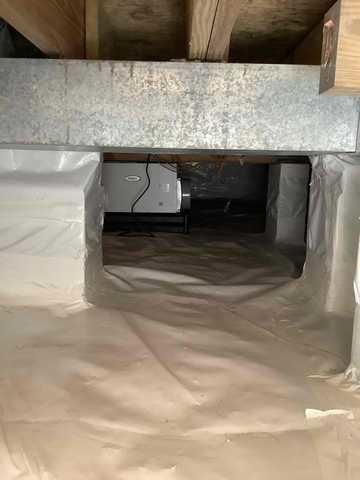
CleanSpace Encapsulation
In order to prevent water from pooling in the crawlspace from exterior seepage, we installed a full perimeter interior dewatering system with a sump pump. We dug an interior drainage trench system, roughly 12 inches wide throughout the perimeter of the crawlspace. Inside the trenches we laid filter cloth that covers the entire bed of soil and ran the tile to an UtraSump pump. Lastly, we placed a bed of stone over the tile to allow extra drainage and to cover the trench. In order to control excess humidity and moisture in the crawlspace, we installed the Cleanspace an Encapsulation liner. The process of installing the encapsulation membrane is to install the wall liner around the full perimeter of the crawlspace. We used anchors to mechanically fastened the encapsulation liner and to the foundation wall. Next, we applied CleanSpace Encapsulation along the walls and floors of the crawlspace. The point of the encapsulation is to isolate the airspace from the soil as well as the moisture that is caused by temperature change on the foundation. This allows the air space to be conditioned. Finally, an AprilAire full crawlspace dehumidifier was installed in order to extract moisture from the air space, and more importantly the lumber, to prevent mold growth from occurring in the future.
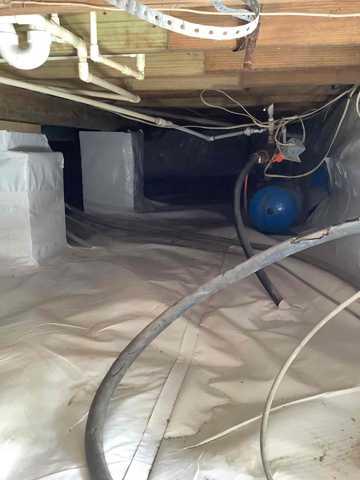
CleanSpace Encapsulation
In order to prevent water from pooling in the crawlspace from exterior seepage, we installed a full perimeter interior dewatering system with a sump pump. We dug an interior drainage trench system, roughly 12 inches wide throughout the perimeter of the crawlspace. Inside the trenches we laid filter cloth that covers the entire bed of soil and ran the tile to an UtraSump pump. Lastly, we placed a bed of stone over the tile to allow extra drainage and to cover the trench. In order to control excess humidity and moisture in the crawlspace, we installed the Cleanspace an Encapsulation liner. The process of installing the encapsulation membrane is to install the wall liner around the full perimeter of the crawlspace. We used anchors to mechanically fastened the encapsulation liner and to the foundation wall. Next, we applied CleanSpace Encapsulation along the walls and floors of the crawlspace. The point of the encapsulation is to isolate the airspace from the soil as well as the moisture that is caused by temperature change on the foundation. This allows the air space to be conditioned. Finally, an AprilAire full crawlspace dehumidifier was installed in order to extract moisture from the air space, and more importantly the lumber, to prevent mold growth from occurring in the future.

CleanSpace Encapsulation
In order to prevent water from pooling in the crawlspace from exterior seepage, we installed a full perimeter interior dewatering system with a sump pump. We dug an interior drainage trench system, roughly 12 inches wide throughout the perimeter of the crawlspace. Inside the trenches we laid filter cloth that covers the entire bed of soil and ran the tile to an UtraSump pump. Lastly, we placed a bed of stone over the tile to allow extra drainage and to cover the trench. In order to control excess humidity and moisture in the crawlspace, we installed the Cleanspace an Encapsulation liner. The process of installing the encapsulation membrane is to install the wall liner around the full perimeter of the crawlspace. We used anchors to mechanically fastened the encapsulation liner and to the foundation wall. Next, we applied CleanSpace Encapsulation along the walls and floors of the crawlspace. The point of the encapsulation is to isolate the airspace from the soil as well as the moisture that is caused by temperature change on the foundation. This allows the air space to be conditioned. Finally, an AprilAire full crawlspace dehumidifier was installed in order to extract moisture from the air space, and more importantly the lumber, to prevent mold growth from occurring in the future.
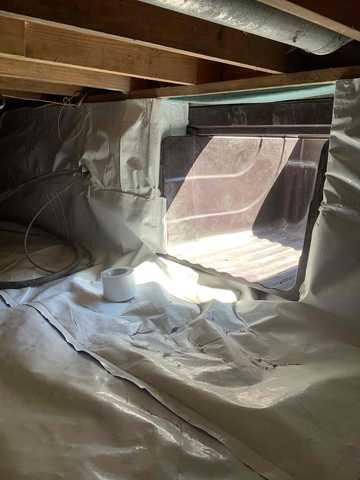
CleanSpace Encapsulation
In order to prevent water from pooling in the crawlspace from exterior seepage, we installed a full perimeter interior dewatering system with a sump pump. We dug an interior drainage trench system, roughly 12 inches wide throughout the perimeter of the crawlspace. Inside the trenches we laid filter cloth that covers the entire bed of soil and ran the tile to an UtraSump pump. Lastly, we placed a bed of stone over the tile to allow extra drainage and to cover the trench. In order to control excess humidity and moisture in the crawlspace, we installed the Cleanspace an Encapsulation liner. The process of installing the encapsulation membrane is to install the wall liner around the full perimeter of the crawlspace. We used anchors to mechanically fastened the encapsulation liner and to the foundation wall. Next, we applied CleanSpace Encapsulation along the walls and floors of the crawlspace. The point of the encapsulation is to isolate the airspace from the soil as well as the moisture that is caused by temperature change on the foundation. This allows the air space to be conditioned. Finally, an AprilAire full crawlspace dehumidifier was installed in order to extract moisture from the air space, and more importantly the lumber, to prevent mold growth from occurring in the future.
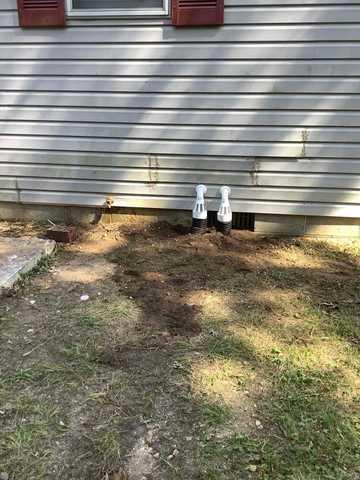
CleanSpace Encapsulation
In order to prevent water from pooling in the crawlspace from exterior seepage, we installed a full perimeter interior dewatering system with a sump pump. We dug an interior drainage trench system, roughly 12 inches wide throughout the perimeter of the crawlspace. Inside the trenches we laid filter cloth that covers the entire bed of soil and ran the tile to an UtraSump pump. Lastly, we placed a bed of stone over the tile to allow extra drainage and to cover the trench. In order to control excess humidity and moisture in the crawlspace, we installed the Cleanspace an Encapsulation liner. The process of installing the encapsulation membrane is to install the wall liner around the full perimeter of the crawlspace. We used anchors to mechanically fastened the encapsulation liner and to the foundation wall. Next, we applied CleanSpace Encapsulation along the walls and floors of the crawlspace. The point of the encapsulation is to isolate the airspace from the soil as well as the moisture that is caused by temperature change on the foundation. This allows the air space to be conditioned. Finally, an AprilAire full crawlspace dehumidifier was installed in order to extract moisture from the air space, and more importantly the lumber, to prevent mold growth from occurring in the future.
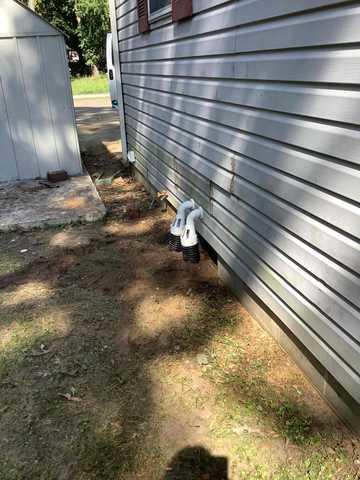
CleanSpace Encapsulation
In order to prevent water from pooling in the crawlspace from exterior seepage, we installed a full perimeter interior dewatering system with a sump pump. We dug an interior drainage trench system, roughly 12 inches wide throughout the perimeter of the crawlspace. Inside the trenches we laid filter cloth that covers the entire bed of soil and ran the tile to an UtraSump pump. Lastly, we placed a bed of stone over the tile to allow extra drainage and to cover the trench. In order to control excess humidity and moisture in the crawlspace, we installed the Cleanspace an Encapsulation liner. The process of installing the encapsulation membrane is to install the wall liner around the full perimeter of the crawlspace. We used anchors to mechanically fastened the encapsulation liner and to the foundation wall. Next, we applied CleanSpace Encapsulation along the walls and floors of the crawlspace. The point of the encapsulation is to isolate the airspace from the soil as well as the moisture that is caused by temperature change on the foundation. This allows the air space to be conditioned. Finally, an AprilAire full crawlspace dehumidifier was installed in order to extract moisture from the air space, and more importantly the lumber, to prevent mold growth from occurring in the future.
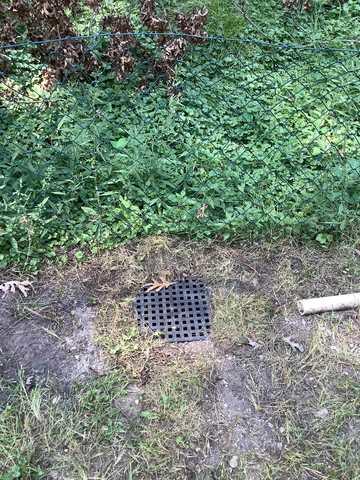
CleanSpace Encapsulation
In order to prevent water from pooling in the crawlspace from exterior seepage, we installed a full perimeter interior dewatering system with a sump pump. We dug an interior drainage trench system, roughly 12 inches wide throughout the perimeter of the crawlspace. Inside the trenches we laid filter cloth that covers the entire bed of soil and ran the tile to an UtraSump pump. Lastly, we placed a bed of stone over the tile to allow extra drainage and to cover the trench. In order to control excess humidity and moisture in the crawlspace, we installed the Cleanspace an Encapsulation liner. The process of installing the encapsulation membrane is to install the wall liner around the full perimeter of the crawlspace. We used anchors to mechanically fastened the encapsulation liner and to the foundation wall. Next, we applied CleanSpace Encapsulation along the walls and floors of the crawlspace. The point of the encapsulation is to isolate the airspace from the soil as well as the moisture that is caused by temperature change on the foundation. This allows the air space to be conditioned. Finally, an AprilAire full crawlspace dehumidifier was installed in order to extract moisture from the air space, and more importantly the lumber, to prevent mold growth from occurring in the future.
